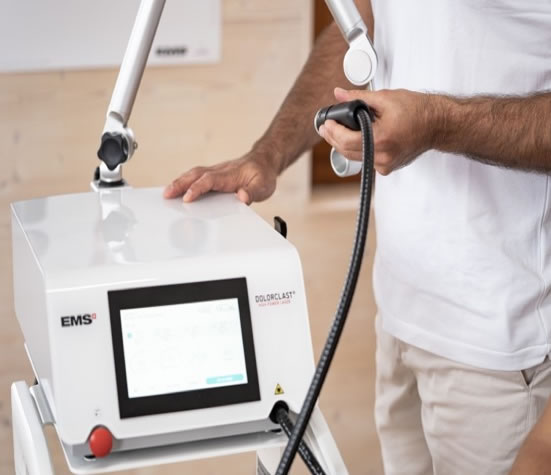Low Level Laser Therapy

Low Level Laser Therapy
What is Low Level Laser Therapy?
Low Level Laser Therapy (LLLT) or Photobiomodulation (PBM) is a low intensity light therapy. The effect is photochemical not thermal. The light triggers biochemical changes within cells and can be compared to the process of photosynthesis in plants, where the photons are absorbed by cellular photoreceptors and triggers chemical changes.
LLLT is Anti-Inflammatory & Promotes Tissue Healing
Through its positive effects on local immune mechanisms, LLLT has a powerful anti-inflammatory effect. This results in immune-mediated healing effects on the injured soft tissues (tendons, ligaments, muscle, joint capsule etc) and also of involved nerves, skin etc.
LLLT stimulates blood flow and lymphatic drainage, improved delivery of oxygen and nutrition to the area, removal of oxygen-free radicals and other waste products, and tissue healing.
Some of the conditions treated by LLLT
- Osteoarthritis of the knee
- Tennis elbow
- Shoulder pain/restriction
- Plantar Fasciopathy (Fasciitis)
- Neuropathic pain
- Ankle sprain/strains
- Wrist sprains/strains
- Temporomandibular joint dysfunction (Jaw pain)

What is Low Lever Laser Therapy?
Low level laser therapy is the application of red and near infra-red light over injuries or lesions to improve wound and soft tissue healing, reduce inflammation and give relief for both acute and chronic pain.
How do we deliver this low lever laser therapy at our clinic?
 We use the Swiss DolorClast High Power Laser machine: The power of the High Power Laser lies in its specially selected laser wavelength (expressed in nanometres [nm]), which determines its depth of penetration. Wavelengths between 650 nm and 1350 nm are defined as the ‘therapeutic window’ for laser therapy. Within this window, the laser penetrates deeply into the tissues rather than being mostly absorbed by water, blood or melanin. As a result, the laser can trigger biological mechanisms crucial for the healing process
We use the Swiss DolorClast High Power Laser machine: The power of the High Power Laser lies in its specially selected laser wavelength (expressed in nanometres [nm]), which determines its depth of penetration. Wavelengths between 650 nm and 1350 nm are defined as the ‘therapeutic window’ for laser therapy. Within this window, the laser penetrates deeply into the tissues rather than being mostly absorbed by water, blood or melanin. As a result, the laser can trigger biological mechanisms crucial for the healing process
Is DolorClast® High Power Laser treatment painful?
No, the treatment is not painful at all! In comparison to other high-power lasers, the patient perceives almost no thermal effect. This is thanks to the specially selected wavelength and short pulse duration of 100 ns, which keep the treated tissues below the thermal threshold and avoid the risk of burns.
How long does it take to see results?
A powerful analgesic effect will be felt 5 minutes after the end of the treatment and is likely to last up to 72 hours. In addition, the decrease of acute inflammation kicks in 60 minutes after the end of the laser session, leading to quick absorption of oedema and faster healing in the damaged tissue.
How many Laser sessions are required?
The number of sessions will depend on the type of pathology. An average of 6 sessions, 3x a week, may be required when the laser is used alone. An average of 3 to 5 sessions, once a week, may be required when the laser is combined with DolorClast® Shock Wave Therapy.
Is there any evidence that low level laser therapy works?
LLLT is not a new medical procedure, in fact it has been around since the 1900s and came into clinical use through its development by NASA on its space station in 1999. There are now over 400 Phase III laboratory trials and 4000 publications on its use in medicine.
LLLT has a long history and strong basic science evidence, which supports its use in pain management. It has few side effects and is well tolerated in the elderly.
A laser does not correct situations involving structural deficits or instabilities whether in bone or soft tissue.
Contact us
Phone & Email
01634 710 980
reception@rochesterchirocentre.com
Alternatively click here to fill out an online enqiury form and we’ll get in touch as soon as possible.

